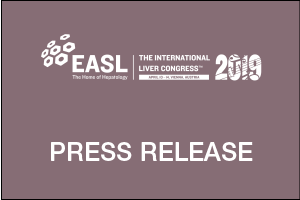
ILC 2019: Population-based study finds ‘critical increase’ in the burden of cirrhosis due to alcohol-related liver disease in Canada, with rising prevalence rates, high rates of late diagnosis, and poor overall survival
13 April 2019, Vienna, Austria
EASL (EUROPEAN ASSOCIATION FOR THE STUDY OF THE LIVER)
Investigators from a large population-based study in Canada have today reported ‘critical increases’ in the burden of cirrhosis following alcohol-related liver disease, with significant recent rises in the prevalence of the condition, high rates of late diagnosis, and poor overall survival. The study, which was presented at The International Liver Congress™ 2019 in Vienna, Austria, found that middle-aged men appear to be bearing the brunt of that burden.
Liver disease accounts for approximately 2 million deaths annually worldwide, with 1 million deaths due to complications of cirrhosis.1 Approximately 50% of all cirrhosis-related deaths can be attributed to alcohol,2 with higher rates of cirrhosis linked to higher rates of alcohol consumption.3 Over the last two decades, efforts have intensified to increase awareness of the risks associated with heavy drinking and improve access to care for individuals with cirrhosis due to alcohol-related liver disease in Canada4 and many other countries.5 However, the impact of these efforts on the natural history of alcohol-related cirrhosis have not been fully evaluated.
To shed more light on the effectiveness of national alcohol harm reduction strategies, researchers from the University of Calgary in Canada undertook a study to evaluate changes in the epidemiology of cirrhosis due to alcohol-related liver disease in the Canadian province of Alberta, which has a population of approximately 4.3 million. A number of population-based databases were interrogated to identify all individuals with cirrhosis due to alcohol-related liver disease between 2013 and 2017.
The overall annual age/sex-adjusted incidence of cirrhosis due to alcohol-related liver disease was found to be 38.9 cases/100,000 for women and 55.6 cases/100,000 for men; the highest incidence rate was observed among men aged 40–59 years (97.4/100,000). While incidence rates remained stable across the study period, prevalence rates increased significantly from 107.7 to 158.2 cases/100,000 between 2013 and 2017 (p<0.01). The prevalence rate was highest among men aged 60–79 years (309.5 cases/100,000). Survival rates at 1, 3, and 5 years were 66.9%, 60.7%, and 55.1%, respectively, with more than 70% of newly-diagnosed individuals presenting with decompensated cirrhosis at the time of diagnosis.
‘This study highlights a critical increase in the prevalence and burden of cirrhosis due to alcohol-related liver disease in this representative Canadian population,’ said Dr Hassan Azhari from the University of Calgary in Canada, who presented the study findings today. ‘The risk of developing cirrhosis due to alcohol-related liver disease was highest among middle-aged men, and survival rates were poor across the entire cohort, primarily because of the late diagnosis. We need to develop more effective preventative strategies and better surveillance practices to detect individuals with alcohol-related liver disease earlier.’
‘Indeed, EASL recommends the implementation of population-level strategies such as raising prices on alcohol through excise taxes and pricing policies,’ said Professor Helena Cortez-Pinto from the Hospital Universitário de Santa Maria, Lisbon, Portugal, and an EASL Governing Board member. ‘Canada has been making efforts in this direction, although it may not be enough. There is also a need for screening for liver disease among patients with alcohol-related problems, in order to diagnose the disease before cirrhosis is present.’
###
About The International Liver Congress™
This annual congress is the biggest event in the EASL calendar, attracting scientific and medical experts from around the world to learn about the latest in liver research. Attending specialists present, share, debate and conclude on the latest science and research in hepatology, working to enhance the treatment and management of liver disease in clinical practice. This year, the congress is expected to attract approximately 10,000 delegates from all corners of the globe. The International Liver Congress™ 2019 will take place from 10–14 April 2019 at the Reed Messe Wien Congress and Exhibition Center, Vienna, Austria.
About The European Association for the Study of the Liver (EASL)
Since its foundation in 1966, this not-for-profit organization has grown to over 4,000 members from all over the world, including many of the leading hepatologists in Europe and beyond. EASL is the leading liver association in Europe, having evolved into a major European association with international influence, and with an impressive track record in promoting research in liver disease, supporting wider education and promoting changes in European liver policy.
Contact
For more information, please contact the ILC Press Office at:
- Email: press2@easloffice.eu
- Telephone: +44 (0)1444 811099
Onsite location reference
Session title: ‘Alcohol related liver disease’
Time, date and location of session: 09:00–09:15, 13 April 2019, Lehar 4
Presenter: Hassan Azhari, Canada
Abstracts: The burden of alcoholic cirrhosis is critically increasing in Canada: A population-based study (PS-175)
Author disclosures
Hassan Azhari has no relevant disclosures
References
- Asrani SK, et al. Burden of liver diseases in the world. J Hepatol. 2019;70(1):151–71.
- Stein E, et al. Heavy daily alcohol intake at the population level predicts the weight of alcohol in cirrhosis burden worldwide. J Hepatol. 2016;65(5):998–1005.
- Rehm J, et al. Global burden of alcoholic liver diseases. J Hepatol. 2013;59(1):160–8.
- Canadian Centre on Substance Abuse. Reducing Alcohol-Related Harm in Canada: Toward a Culture of Moderation. Recommendations for a National Alcohol Strategy. April 2007. Available from: http://www.ccdus.ca/Eng/topics/alcohol/Pages/default.aspx. Last accessed: February 2019.
- World Health Organization. Global status report on alcohol and health 2018. Available from: https://apps.who.int/iris/bitstream/handle/10665/274603/9789241565639-eng.pdf. Last accessed: February 2019.
